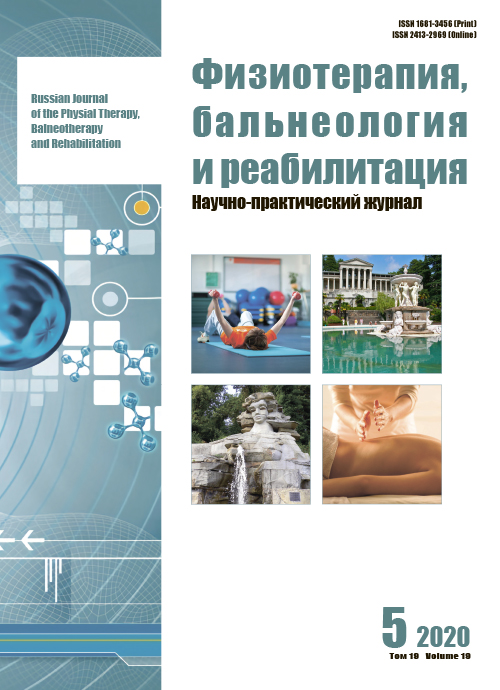Practical aspects of using exercise therapy methods for the rehabilitation of patients with COVID-19
- Authors: Samoilov A.S.1, Khan A.V.1, Nazaryan S.E.1, Pustovoit V.I.1, Petrova M.S.2, Novikova A.A.1
-
Affiliations:
- State Research Center – Burnasyan Federal Medical Biophysical Center of Federal Medical Biological Agency
- Central State Medical Academy of Department of Presidential Affairs
- Issue: Vol 19, No 5 (2020)
- Pages: 305-311
- Section: Clinical notes and case reports
- Published: 20.06.2021
- URL: https://rjpbr.com/1681-3456/article/view/71699
- DOI: https://doi.org/10.17816/1681-3456-2020-19-5-5
- ID: 71699
Cite item
Abstract
In the article it is discussed about the approved methods of using physical therapy on patients with different forms of COVID-19 at the stage of inpatient treatment. The study involved 86 patients with varying degrees of lung tissue damage (CT2–CT4), the main group included 49 patients, and the control group included 37 patients. A scheme of rehabilitation measures that can be used in patients with SARS-CoV-19 is proposed. Methods of therapeutic and respiratory gymnastics for both passive and active work with patients to restore muscle strength, improve sputum outflow, prevent deep vein thrombosis and bedsores with various degrees of lung tissue damage are described. The importance of performing physical therapy techniques in the early stages, when the patient is still in bed, is shown. Using the modified Questionnaire "quality of life" (GAD-9), the effectiveness of respiratory and therapeutic exercises was confirmed.
Full Text
About the authors
Alexandr S. Samoilov
State Research Center – Burnasyan Federal Medical Biophysical Center of Federal Medical Biological Agency
Email: sveta-nazaryan@yandex.ru
SPIN-code: 3771-4848
Scopus Author ID: 57200643078
Dr. Sci. (Med.), Professor
Russian Federation, MoscowAlexey V. Khan
State Research Center – Burnasyan Federal Medical Biophysical Center of Federal Medical Biological Agency
Email: sveta-nazaryan@yandex.ru
ORCID iD: 0000-0002-4796-7038
SPIN-code: 7241-3983
Russian Federation, Moscow
Svetlana E. Nazaryan
State Research Center – Burnasyan Federal Medical Biophysical Center of Federal Medical Biological Agency
Author for correspondence.
Email: sveta-nazaryan@yandex.ru
ORCID iD: 0000-0002-6199-872X
SPIN-code: 7981-8752
Russian Federation, Moscow
Vasiliy I. Pustovoit
State Research Center – Burnasyan Federal Medical Biophysical Center of Federal Medical Biological Agency
Email: sveta-nazaryan@yandex.ru
ORCID iD: 0000-0003-3396-5813
SPIN-code: 2079-1027
Associate
Russian Federation, MoscowMariya S. Petrova
Central State Medical Academy of Department of Presidential Affairs
Email: sveta-nazaryan@yandex.ru
ORCID iD: 0000-0002-9702-5487
SPIN-code: 2316-1306
Russian Federation, Moscow
Anastasiya A. Novikova
State Research Center – Burnasyan Federal Medical Biophysical Center of Federal Medical Biological Agency
Email: sveta-nazaryan@yandex.ru
ORCID iD: 0000-0002-7592-051X
SPIN-code: 5679-0630
Russian Federation, Moscow
References
- Temporary guidelines "Prevention, diagnosis and treatment of new coronavirus infection (COVID-19). Version 6" (approved by the Ministry of Health of the Russian Federation on 28.04.2020). Available from: https://base.garant.ru/73964533/
- Razinkin SM, Petrova VV, Fomin PA, et al. Justification of the method for evaluating the effectiveness of management of the psychophysiological state of a person. Bulletin of Neurology, Psychiatry, and Neurosurgery. 2017;(7):13–23. (In Russ).
- Nikiforov VV, Suranova TG, Mironov AYu, et al. New coronavirus infection (COVID-19): etiology, epidemiology, clinic, diagnosis, treatment and prevention. Moscow; 2020. 48 р. (In Russ).
- Samoilov AS, Razinkin SM, Nazaryan SE, et al. Multidisciplinary approach in the rehabilitation of high-performance athletes. Questions of Balneology, Physiotherapy and Physical Therapy. 2016;93(2):147. (In Russ).
- Ambrosino N, Makhabah DN. Comprehensive physiotherapy management in ARDS. Minerva Anestesiol. 2013;79(5):554–563.
- Fan E. Critical illness neuromyopathy and the role of physical therapy and rehabilitation in critically ill patients. Respir Care. 2012;57(6):933–944; discussion 44–46. doi: 10.4187/respcare.01634
- Guerin C, Reignier J, Richard JC, et al. Prone positioning in severe acute respiratory distress syndrome. N Engl J Med. 2013; 368(23):2159–2168. doi: 10.1056/NEJMoa1214103
- Lau HM, Ng GY, Jones AY, et al. A randomised controlled trial of the effectiveness of an exercise training program in patients recovering from severe acute respiratory syndrome. Aust J Physiother. 2005;51(4):213–219. doi: 10.1016/s0004-9514(05)70002-7
- Nazaryan SE, Petrova MS, Khan AV, Smirnova A.V. Experience of combining rehabilitation measures with the pre-competition period of the training process on the example of track and field athletics. Questions of Balneology, Physiotherapy and Physical Therapy. 2016;93(2):122–123. (In Russ).
- Samoilov AS, Udalov YuD, Nazaryan SE, Naikina AV. Influence of the level of physical activity on the course of pneumonia caused by COVID-19. Medicine of Extreme Situations. 2020;(3). (In Russ). doi: 10.47183/mes.2020.004
- Lim PA, Ng YS, Tay BK. Impact of a viral respiratory epidemic on the practice of medicine and rehabilitation: severe acute respiratory syndrome. Arch Phys Med Rehabil. 2004;85(8):1365–1370. doi: 10.1016/j.apmr.2004.01.022
- Guan WJ, Ni ZY, Hu Y, et al. Clinical characteristics of Coronavirus disease 2019 in China. N Engl J Med. 2020;382(18):1708–1720. doi: 10.1056/NEJMoa2002032
- Baig AM, Khaleeq A, Ali U, Syeda H. Evidence of the COVID-19 Virus Targeting the CNS: Tissue distribution, host-virus interaction, and proposed neurotropic mechanisms. ACS Chem Neurosci. 2020;11(7):995–998. doi: 10.1021/acschemneuro.0c00122
- Ding L, Wang L, Ma W, He H. Efficacy and safety of early prone positioning combined with HFNC or NIV in moderate to severe ARDS: a multi-center prospective cohort study. Crit Care. 2020;24(1):28. doi: 10.1186/s13054-020-2738-5
- An algorithm for the application of methods of physical therapy in patients who have undergone COVID-19, after viral pneumonia and its complications. Methodological recommendations, Moscow: A.I. Burnazyan FMBC; 2020.
Supplementary files










